Application of Structural Principles in Commercial Construction Report
VerifiedAdded on 2020/04/21
|13
|2699
|422
Report
AI Summary
This report provides a comprehensive analysis of structural principles applied in the construction of the Old Parliament House, a low-rise commercial building. It examines the building's various systems, including the footing system, which considers deep and shallow foundations to accommodate soil conditions; the structural system, focusing on the steel portal frame and its role in load bearing and wind resistance; the floor system, including waffle raft and suspended concrete slabs; the wall system, discussing both solid and cavity wall construction; the services, such as stormwater management, power generation, and fire safety; and finally, the roof system, highlighting the use of steel roof structures. The report delves into the design considerations, material choices, and functional aspects of each system, offering insights into the building's overall structural integrity and performance. The assessment considers various factors like soil conditions, load types, and building codes to provide a holistic view of the structural design.
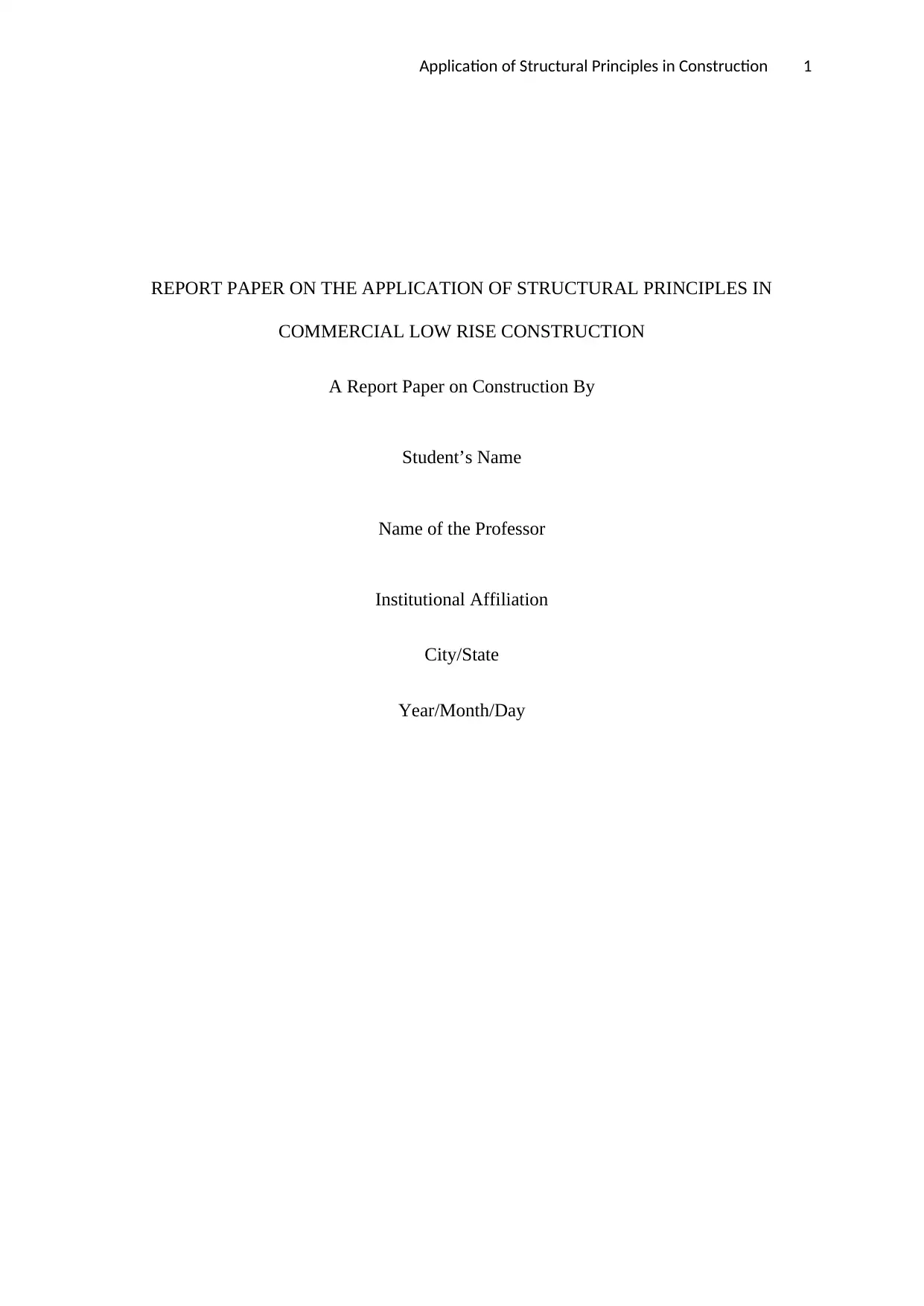
Application of Structural Principles in Construction 1
REPORT PAPER ON THE APPLICATION OF STRUCTURAL PRINCIPLES IN
COMMERCIAL LOW RISE CONSTRUCTION
A Report Paper on Construction By
Student’s Name
Name of the Professor
Institutional Affiliation
City/State
Year/Month/Day
REPORT PAPER ON THE APPLICATION OF STRUCTURAL PRINCIPLES IN
COMMERCIAL LOW RISE CONSTRUCTION
A Report Paper on Construction By
Student’s Name
Name of the Professor
Institutional Affiliation
City/State
Year/Month/Day
Paraphrase This Document
Need a fresh take? Get an instant paraphrase of this document with our AI Paraphraser
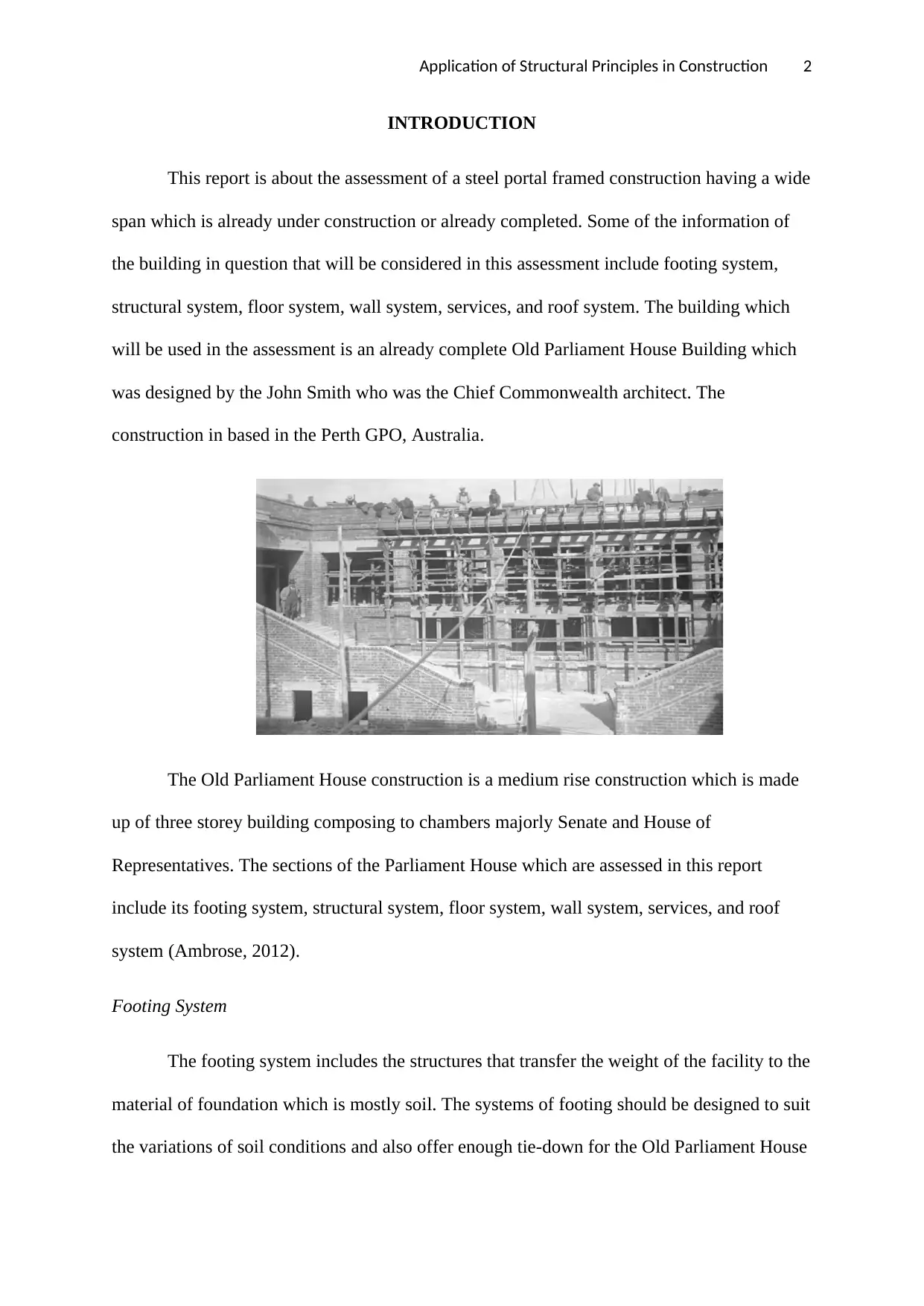
Application of Structural Principles in Construction 2
INTRODUCTION
This report is about the assessment of a steel portal framed construction having a wide
span which is already under construction or already completed. Some of the information of
the building in question that will be considered in this assessment include footing system,
structural system, floor system, wall system, services, and roof system. The building which
will be used in the assessment is an already complete Old Parliament House Building which
was designed by the John Smith who was the Chief Commonwealth architect. The
construction in based in the Perth GPO, Australia.
The Old Parliament House construction is a medium rise construction which is made
up of three storey building composing to chambers majorly Senate and House of
Representatives. The sections of the Parliament House which are assessed in this report
include its footing system, structural system, floor system, wall system, services, and roof
system (Ambrose, 2012).
Footing System
The footing system includes the structures that transfer the weight of the facility to the
material of foundation which is mostly soil. The systems of footing should be designed to suit
the variations of soil conditions and also offer enough tie-down for the Old Parliament House
INTRODUCTION
This report is about the assessment of a steel portal framed construction having a wide
span which is already under construction or already completed. Some of the information of
the building in question that will be considered in this assessment include footing system,
structural system, floor system, wall system, services, and roof system. The building which
will be used in the assessment is an already complete Old Parliament House Building which
was designed by the John Smith who was the Chief Commonwealth architect. The
construction in based in the Perth GPO, Australia.
The Old Parliament House construction is a medium rise construction which is made
up of three storey building composing to chambers majorly Senate and House of
Representatives. The sections of the Parliament House which are assessed in this report
include its footing system, structural system, floor system, wall system, services, and roof
system (Ambrose, 2012).
Footing System
The footing system includes the structures that transfer the weight of the facility to the
material of foundation which is mostly soil. The systems of footing should be designed to suit
the variations of soil conditions and also offer enough tie-down for the Old Parliament House
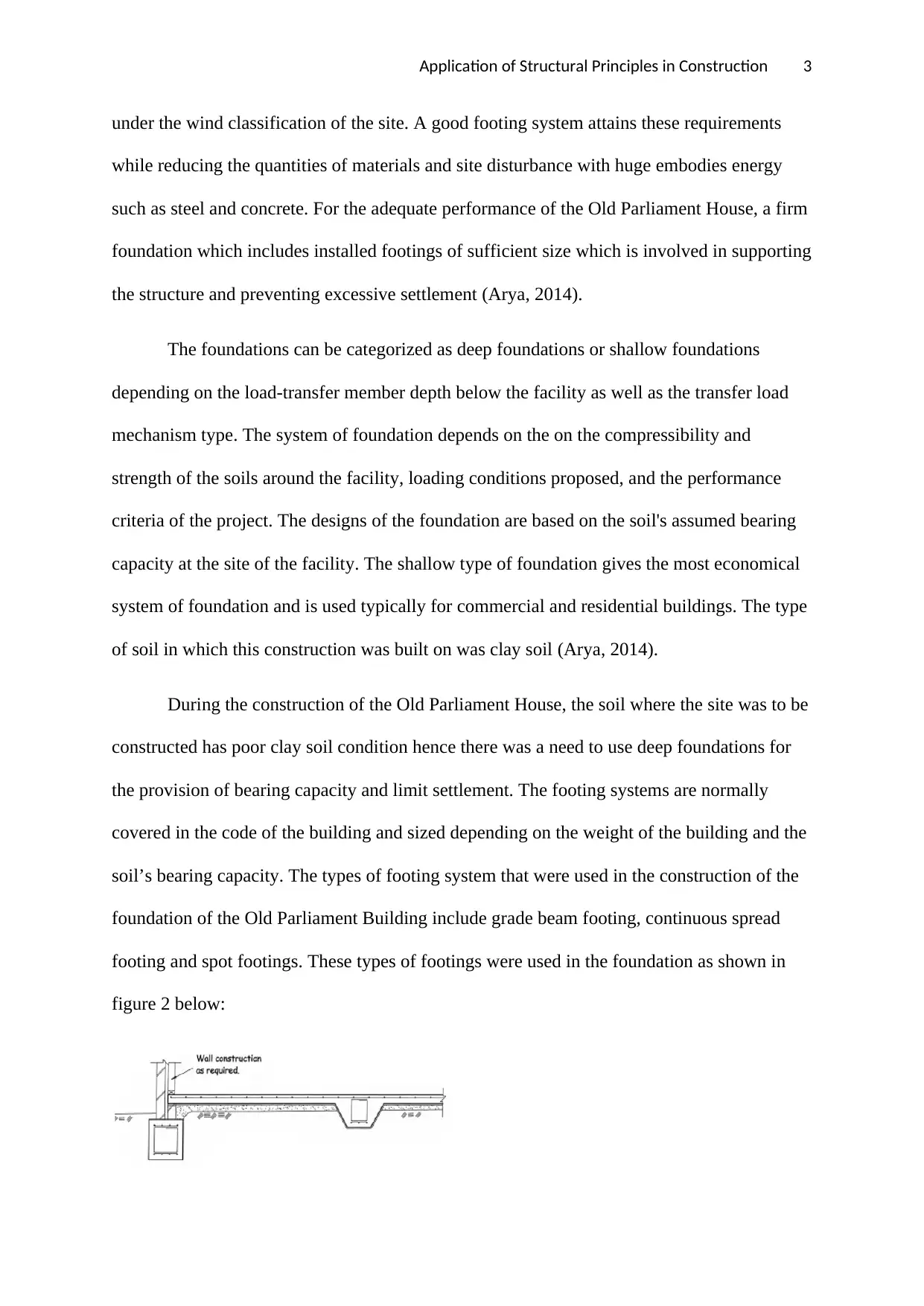
Application of Structural Principles in Construction 3
under the wind classification of the site. A good footing system attains these requirements
while reducing the quantities of materials and site disturbance with huge embodies energy
such as steel and concrete. For the adequate performance of the Old Parliament House, a firm
foundation which includes installed footings of sufficient size which is involved in supporting
the structure and preventing excessive settlement (Arya, 2014).
The foundations can be categorized as deep foundations or shallow foundations
depending on the load-transfer member depth below the facility as well as the transfer load
mechanism type. The system of foundation depends on the on the compressibility and
strength of the soils around the facility, loading conditions proposed, and the performance
criteria of the project. The designs of the foundation are based on the soil's assumed bearing
capacity at the site of the facility. The shallow type of foundation gives the most economical
system of foundation and is used typically for commercial and residential buildings. The type
of soil in which this construction was built on was clay soil (Arya, 2014).
During the construction of the Old Parliament House, the soil where the site was to be
constructed has poor clay soil condition hence there was a need to use deep foundations for
the provision of bearing capacity and limit settlement. The footing systems are normally
covered in the code of the building and sized depending on the weight of the building and the
soil’s bearing capacity. The types of footing system that were used in the construction of the
foundation of the Old Parliament Building include grade beam footing, continuous spread
footing and spot footings. These types of footings were used in the foundation as shown in
figure 2 below:
under the wind classification of the site. A good footing system attains these requirements
while reducing the quantities of materials and site disturbance with huge embodies energy
such as steel and concrete. For the adequate performance of the Old Parliament House, a firm
foundation which includes installed footings of sufficient size which is involved in supporting
the structure and preventing excessive settlement (Arya, 2014).
The foundations can be categorized as deep foundations or shallow foundations
depending on the load-transfer member depth below the facility as well as the transfer load
mechanism type. The system of foundation depends on the on the compressibility and
strength of the soils around the facility, loading conditions proposed, and the performance
criteria of the project. The designs of the foundation are based on the soil's assumed bearing
capacity at the site of the facility. The shallow type of foundation gives the most economical
system of foundation and is used typically for commercial and residential buildings. The type
of soil in which this construction was built on was clay soil (Arya, 2014).
During the construction of the Old Parliament House, the soil where the site was to be
constructed has poor clay soil condition hence there was a need to use deep foundations for
the provision of bearing capacity and limit settlement. The footing systems are normally
covered in the code of the building and sized depending on the weight of the building and the
soil’s bearing capacity. The types of footing system that were used in the construction of the
foundation of the Old Parliament Building include grade beam footing, continuous spread
footing and spot footings. These types of footings were used in the foundation as shown in
figure 2 below:
⊘ This is a preview!⊘
Do you want full access?
Subscribe today to unlock all pages.

Trusted by 1+ million students worldwide
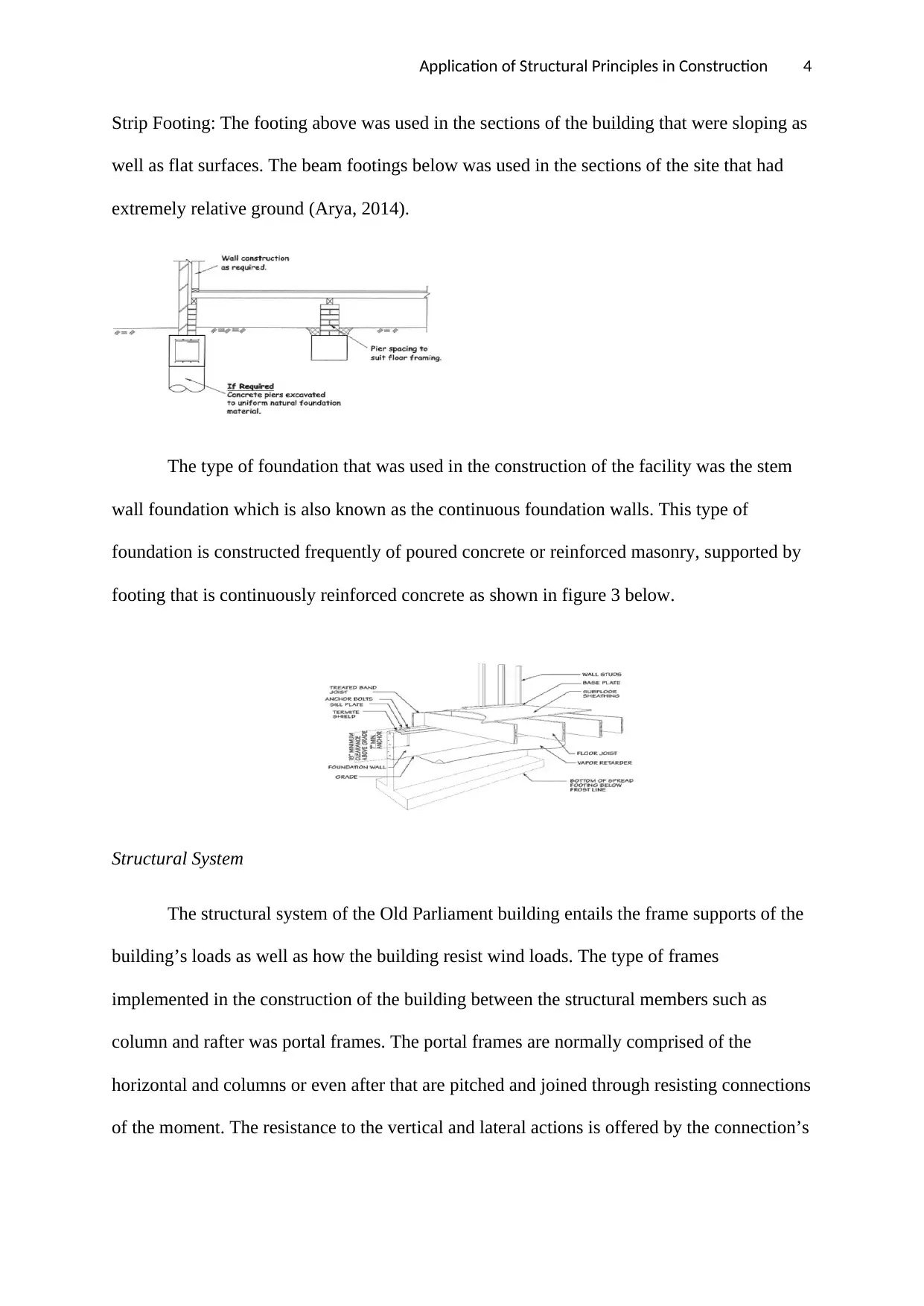
Application of Structural Principles in Construction 4
Strip Footing: The footing above was used in the sections of the building that were sloping as
well as flat surfaces. The beam footings below was used in the sections of the site that had
extremely relative ground (Arya, 2014).
The type of foundation that was used in the construction of the facility was the stem
wall foundation which is also known as the continuous foundation walls. This type of
foundation is constructed frequently of poured concrete or reinforced masonry, supported by
footing that is continuously reinforced concrete as shown in figure 3 below.
Structural System
The structural system of the Old Parliament building entails the frame supports of the
building’s loads as well as how the building resist wind loads. The type of frames
implemented in the construction of the building between the structural members such as
column and rafter was portal frames. The portal frames are normally comprised of the
horizontal and columns or even after that are pitched and joined through resisting connections
of the moment. The resistance to the vertical and lateral actions is offered by the connection’s
Strip Footing: The footing above was used in the sections of the building that were sloping as
well as flat surfaces. The beam footings below was used in the sections of the site that had
extremely relative ground (Arya, 2014).
The type of foundation that was used in the construction of the facility was the stem
wall foundation which is also known as the continuous foundation walls. This type of
foundation is constructed frequently of poured concrete or reinforced masonry, supported by
footing that is continuously reinforced concrete as shown in figure 3 below.
Structural System
The structural system of the Old Parliament building entails the frame supports of the
building’s loads as well as how the building resist wind loads. The type of frames
implemented in the construction of the building between the structural members such as
column and rafter was portal frames. The portal frames are normally comprised of the
horizontal and columns or even after that are pitched and joined through resisting connections
of the moment. The resistance to the vertical and lateral actions is offered by the connection’s
Paraphrase This Document
Need a fresh take? Get an instant paraphrase of this document with our AI Paraphraser
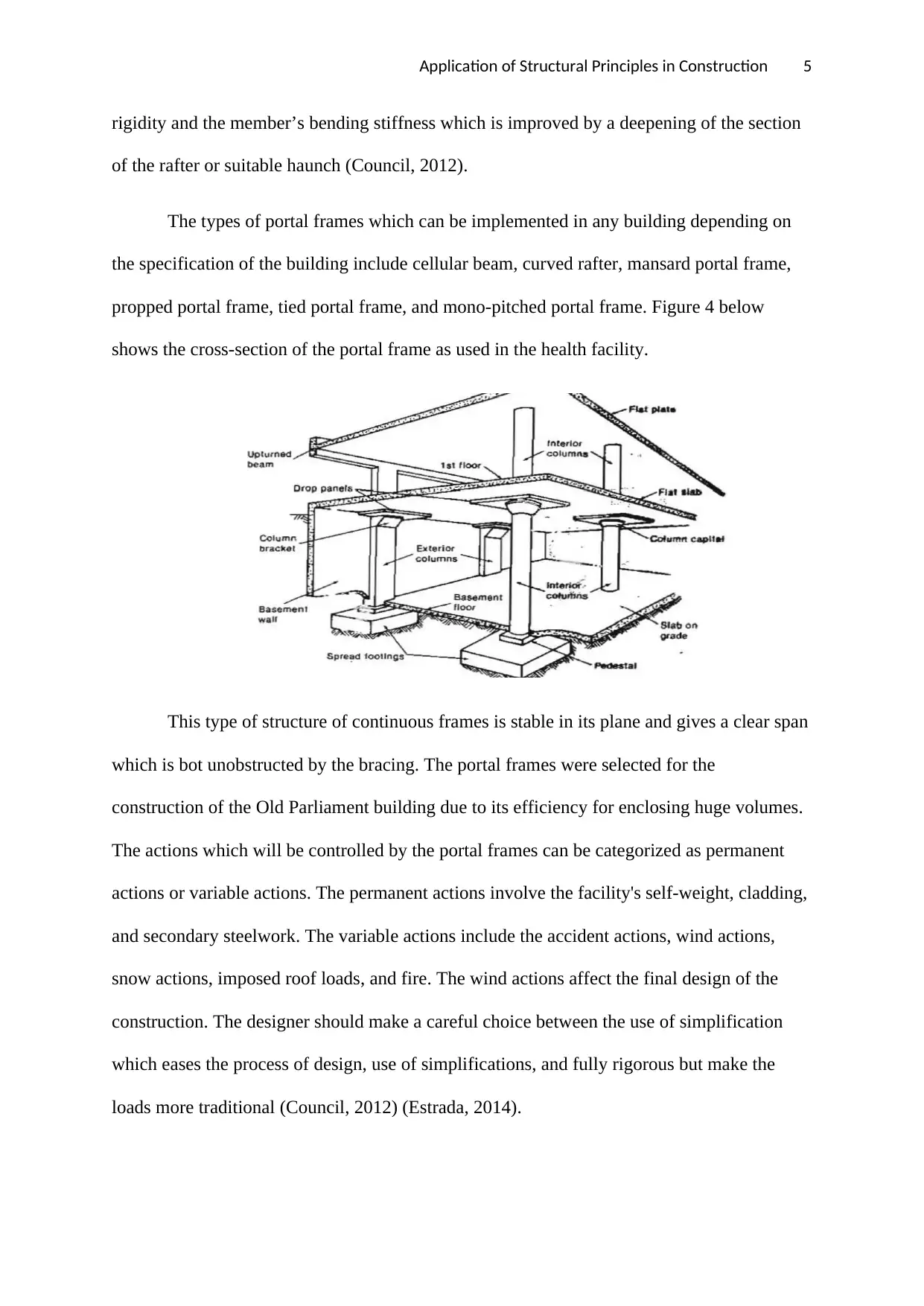
Application of Structural Principles in Construction 5
rigidity and the member’s bending stiffness which is improved by a deepening of the section
of the rafter or suitable haunch (Council, 2012).
The types of portal frames which can be implemented in any building depending on
the specification of the building include cellular beam, curved rafter, mansard portal frame,
propped portal frame, tied portal frame, and mono-pitched portal frame. Figure 4 below
shows the cross-section of the portal frame as used in the health facility.
This type of structure of continuous frames is stable in its plane and gives a clear span
which is bot unobstructed by the bracing. The portal frames were selected for the
construction of the Old Parliament building due to its efficiency for enclosing huge volumes.
The actions which will be controlled by the portal frames can be categorized as permanent
actions or variable actions. The permanent actions involve the facility's self-weight, cladding,
and secondary steelwork. The variable actions include the accident actions, wind actions,
snow actions, imposed roof loads, and fire. The wind actions affect the final design of the
construction. The designer should make a careful choice between the use of simplification
which eases the process of design, use of simplifications, and fully rigorous but make the
loads more traditional (Council, 2012) (Estrada, 2014).
rigidity and the member’s bending stiffness which is improved by a deepening of the section
of the rafter or suitable haunch (Council, 2012).
The types of portal frames which can be implemented in any building depending on
the specification of the building include cellular beam, curved rafter, mansard portal frame,
propped portal frame, tied portal frame, and mono-pitched portal frame. Figure 4 below
shows the cross-section of the portal frame as used in the health facility.
This type of structure of continuous frames is stable in its plane and gives a clear span
which is bot unobstructed by the bracing. The portal frames were selected for the
construction of the Old Parliament building due to its efficiency for enclosing huge volumes.
The actions which will be controlled by the portal frames can be categorized as permanent
actions or variable actions. The permanent actions involve the facility's self-weight, cladding,
and secondary steelwork. The variable actions include the accident actions, wind actions,
snow actions, imposed roof loads, and fire. The wind actions affect the final design of the
construction. The designer should make a careful choice between the use of simplification
which eases the process of design, use of simplifications, and fully rigorous but make the
loads more traditional (Council, 2012) (Estrada, 2014).
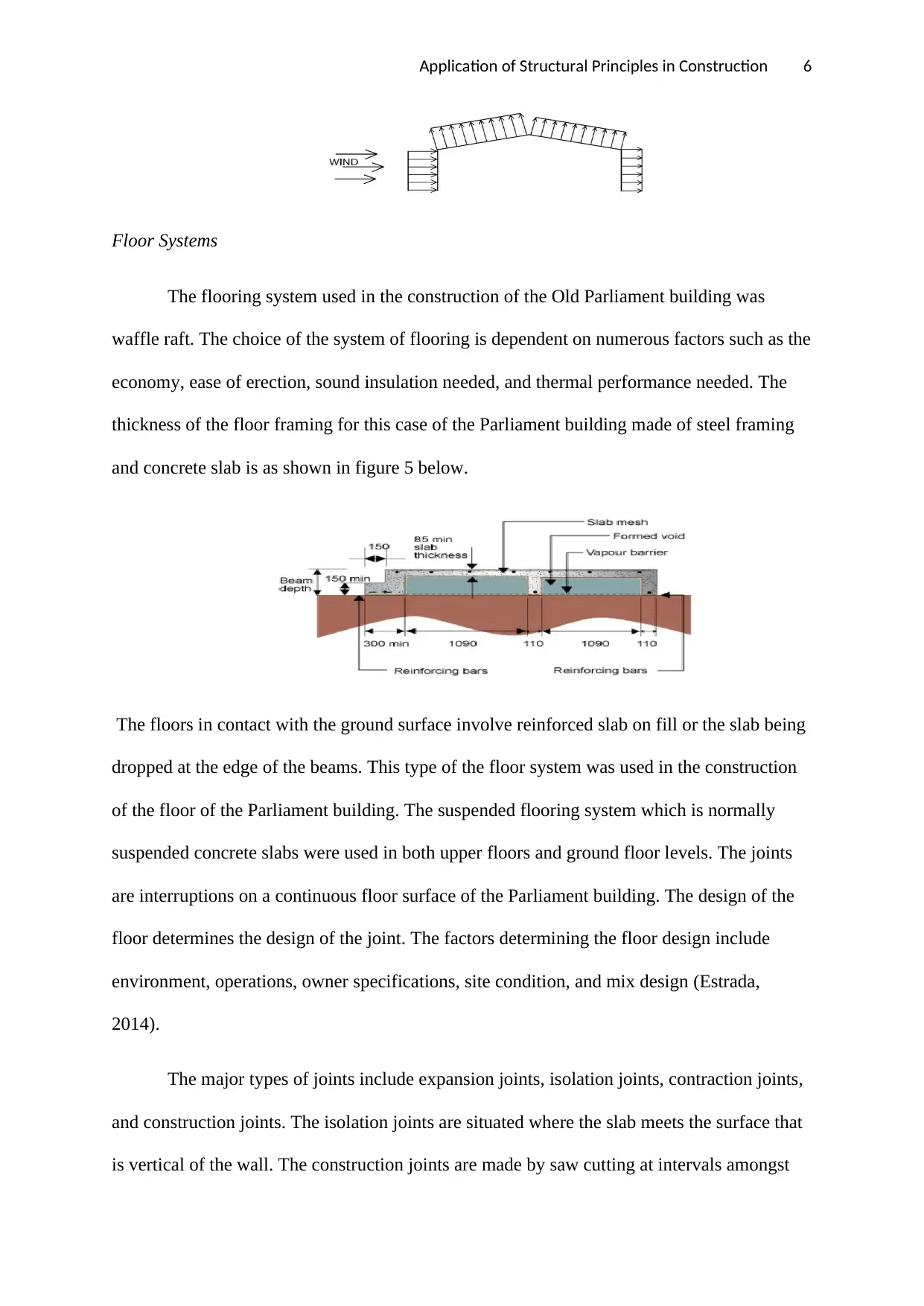
Application of Structural Principles in Construction 6
Floor Systems
The flooring system used in the construction of the Old Parliament building was
waffle raft. The choice of the system of flooring is dependent on numerous factors such as the
economy, ease of erection, sound insulation needed, and thermal performance needed. The
thickness of the floor framing for this case of the Parliament building made of steel framing
and concrete slab is as shown in figure 5 below.
The floors in contact with the ground surface involve reinforced slab on fill or the slab being
dropped at the edge of the beams. This type of the floor system was used in the construction
of the floor of the Parliament building. The suspended flooring system which is normally
suspended concrete slabs were used in both upper floors and ground floor levels. The joints
are interruptions on a continuous floor surface of the Parliament building. The design of the
floor determines the design of the joint. The factors determining the floor design include
environment, operations, owner specifications, site condition, and mix design (Estrada,
2014).
The major types of joints include expansion joints, isolation joints, contraction joints,
and construction joints. The isolation joints are situated where the slab meets the surface that
is vertical of the wall. The construction joints are made by saw cutting at intervals amongst
Floor Systems
The flooring system used in the construction of the Old Parliament building was
waffle raft. The choice of the system of flooring is dependent on numerous factors such as the
economy, ease of erection, sound insulation needed, and thermal performance needed. The
thickness of the floor framing for this case of the Parliament building made of steel framing
and concrete slab is as shown in figure 5 below.
The floors in contact with the ground surface involve reinforced slab on fill or the slab being
dropped at the edge of the beams. This type of the floor system was used in the construction
of the floor of the Parliament building. The suspended flooring system which is normally
suspended concrete slabs were used in both upper floors and ground floor levels. The joints
are interruptions on a continuous floor surface of the Parliament building. The design of the
floor determines the design of the joint. The factors determining the floor design include
environment, operations, owner specifications, site condition, and mix design (Estrada,
2014).
The major types of joints include expansion joints, isolation joints, contraction joints,
and construction joints. The isolation joints are situated where the slab meets the surface that
is vertical of the wall. The construction joints are made by saw cutting at intervals amongst
⊘ This is a preview!⊘
Do you want full access?
Subscribe today to unlock all pages.

Trusted by 1+ million students worldwide
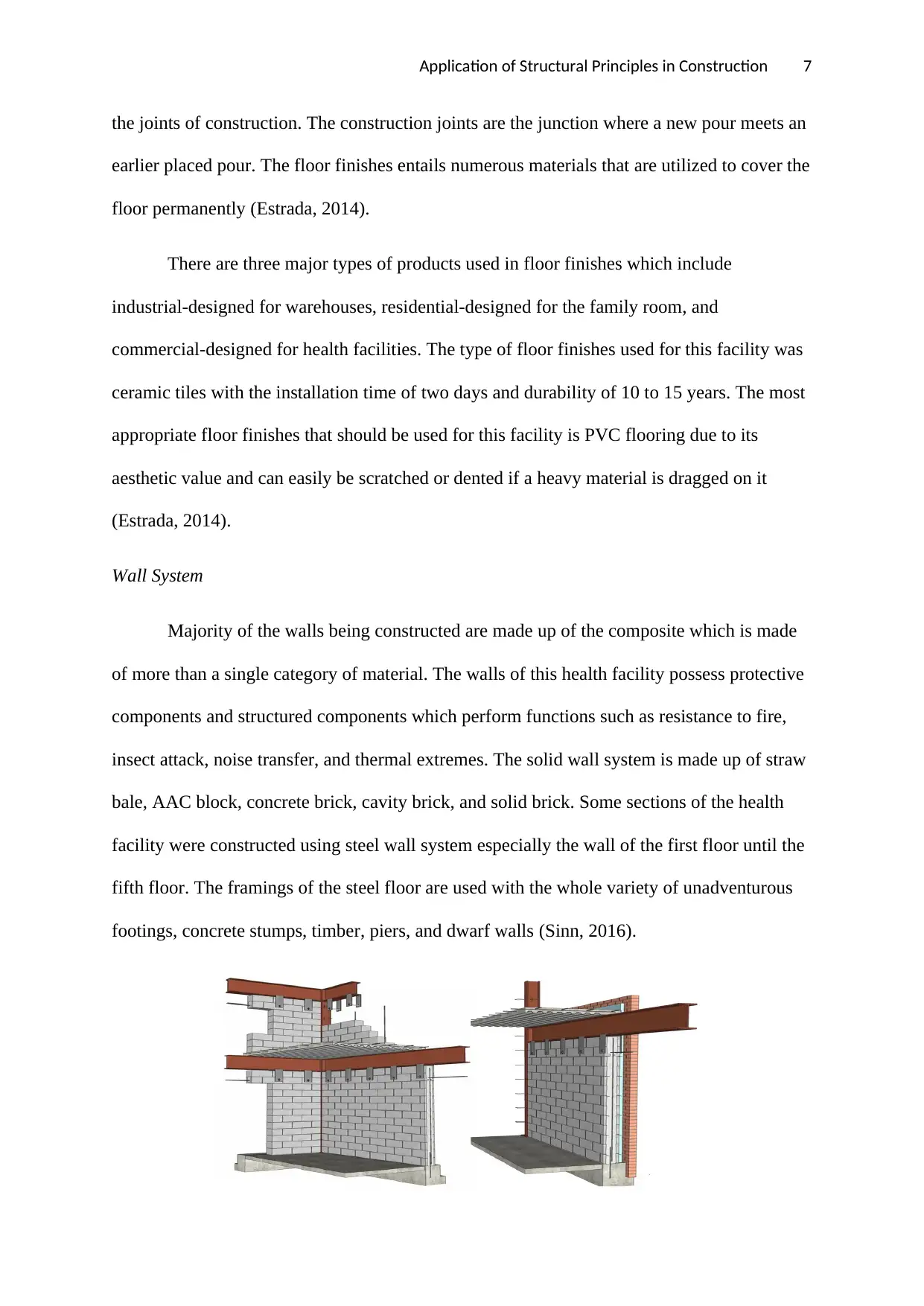
Application of Structural Principles in Construction 7
the joints of construction. The construction joints are the junction where a new pour meets an
earlier placed pour. The floor finishes entails numerous materials that are utilized to cover the
floor permanently (Estrada, 2014).
There are three major types of products used in floor finishes which include
industrial-designed for warehouses, residential-designed for the family room, and
commercial-designed for health facilities. The type of floor finishes used for this facility was
ceramic tiles with the installation time of two days and durability of 10 to 15 years. The most
appropriate floor finishes that should be used for this facility is PVC flooring due to its
aesthetic value and can easily be scratched or dented if a heavy material is dragged on it
(Estrada, 2014).
Wall System
Majority of the walls being constructed are made up of the composite which is made
of more than a single category of material. The walls of this health facility possess protective
components and structured components which perform functions such as resistance to fire,
insect attack, noise transfer, and thermal extremes. The solid wall system is made up of straw
bale, AAC block, concrete brick, cavity brick, and solid brick. Some sections of the health
facility were constructed using steel wall system especially the wall of the first floor until the
fifth floor. The framings of the steel floor are used with the whole variety of unadventurous
footings, concrete stumps, timber, piers, and dwarf walls (Sinn, 2016).
the joints of construction. The construction joints are the junction where a new pour meets an
earlier placed pour. The floor finishes entails numerous materials that are utilized to cover the
floor permanently (Estrada, 2014).
There are three major types of products used in floor finishes which include
industrial-designed for warehouses, residential-designed for the family room, and
commercial-designed for health facilities. The type of floor finishes used for this facility was
ceramic tiles with the installation time of two days and durability of 10 to 15 years. The most
appropriate floor finishes that should be used for this facility is PVC flooring due to its
aesthetic value and can easily be scratched or dented if a heavy material is dragged on it
(Estrada, 2014).
Wall System
Majority of the walls being constructed are made up of the composite which is made
of more than a single category of material. The walls of this health facility possess protective
components and structured components which perform functions such as resistance to fire,
insect attack, noise transfer, and thermal extremes. The solid wall system is made up of straw
bale, AAC block, concrete brick, cavity brick, and solid brick. Some sections of the health
facility were constructed using steel wall system especially the wall of the first floor until the
fifth floor. The framings of the steel floor are used with the whole variety of unadventurous
footings, concrete stumps, timber, piers, and dwarf walls (Sinn, 2016).
Paraphrase This Document
Need a fresh take? Get an instant paraphrase of this document with our AI Paraphraser
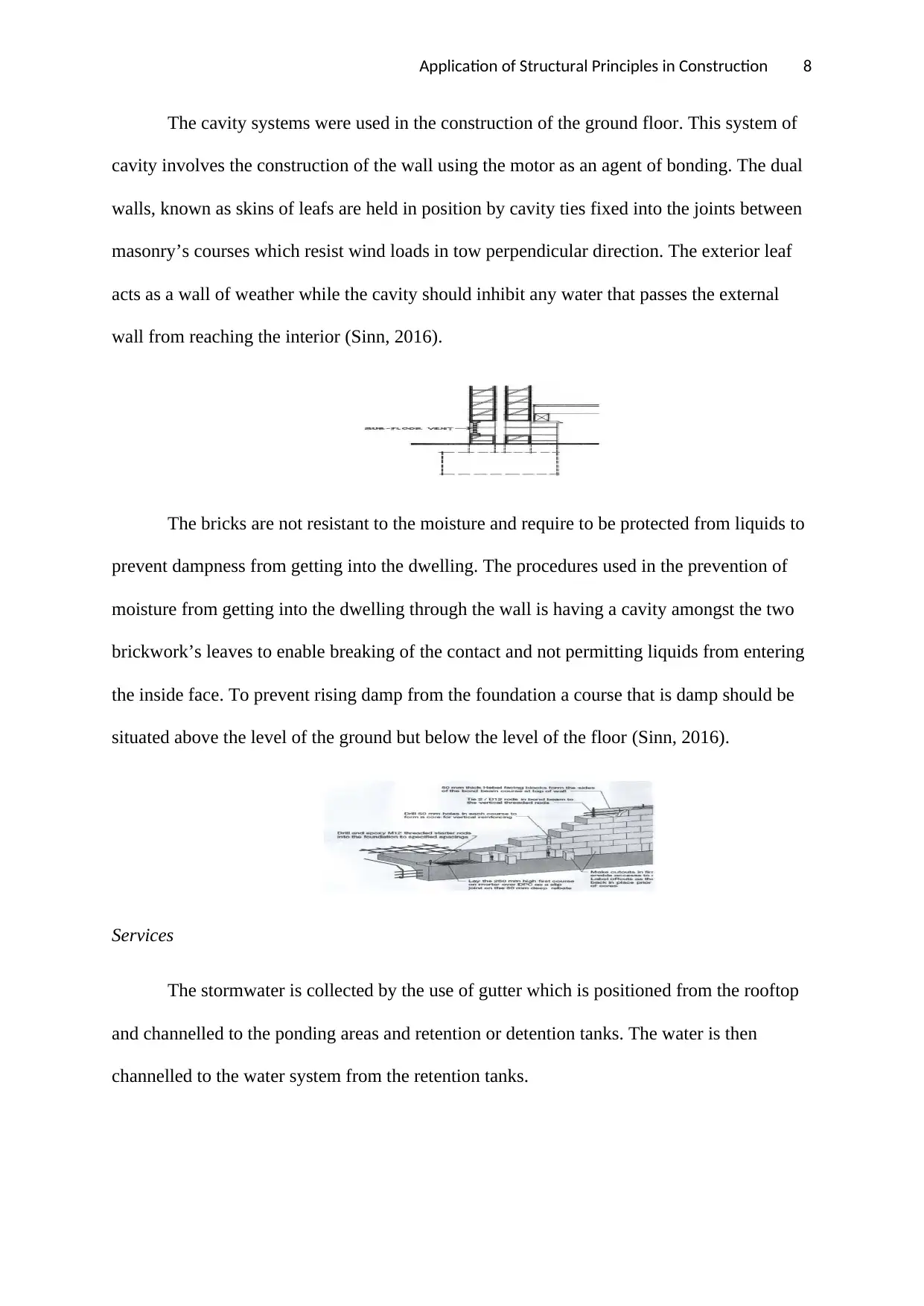
Application of Structural Principles in Construction 8
The cavity systems were used in the construction of the ground floor. This system of
cavity involves the construction of the wall using the motor as an agent of bonding. The dual
walls, known as skins of leafs are held in position by cavity ties fixed into the joints between
masonry’s courses which resist wind loads in tow perpendicular direction. The exterior leaf
acts as a wall of weather while the cavity should inhibit any water that passes the external
wall from reaching the interior (Sinn, 2016).
The bricks are not resistant to the moisture and require to be protected from liquids to
prevent dampness from getting into the dwelling. The procedures used in the prevention of
moisture from getting into the dwelling through the wall is having a cavity amongst the two
brickwork’s leaves to enable breaking of the contact and not permitting liquids from entering
the inside face. To prevent rising damp from the foundation a course that is damp should be
situated above the level of the ground but below the level of the floor (Sinn, 2016).
Services
The stormwater is collected by the use of gutter which is positioned from the rooftop
and channelled to the ponding areas and retention or detention tanks. The water is then
channelled to the water system from the retention tanks.
The cavity systems were used in the construction of the ground floor. This system of
cavity involves the construction of the wall using the motor as an agent of bonding. The dual
walls, known as skins of leafs are held in position by cavity ties fixed into the joints between
masonry’s courses which resist wind loads in tow perpendicular direction. The exterior leaf
acts as a wall of weather while the cavity should inhibit any water that passes the external
wall from reaching the interior (Sinn, 2016).
The bricks are not resistant to the moisture and require to be protected from liquids to
prevent dampness from getting into the dwelling. The procedures used in the prevention of
moisture from getting into the dwelling through the wall is having a cavity amongst the two
brickwork’s leaves to enable breaking of the contact and not permitting liquids from entering
the inside face. To prevent rising damp from the foundation a course that is damp should be
situated above the level of the ground but below the level of the floor (Sinn, 2016).
Services
The stormwater is collected by the use of gutter which is positioned from the rooftop
and channelled to the ponding areas and retention or detention tanks. The water is then
channelled to the water system from the retention tanks.
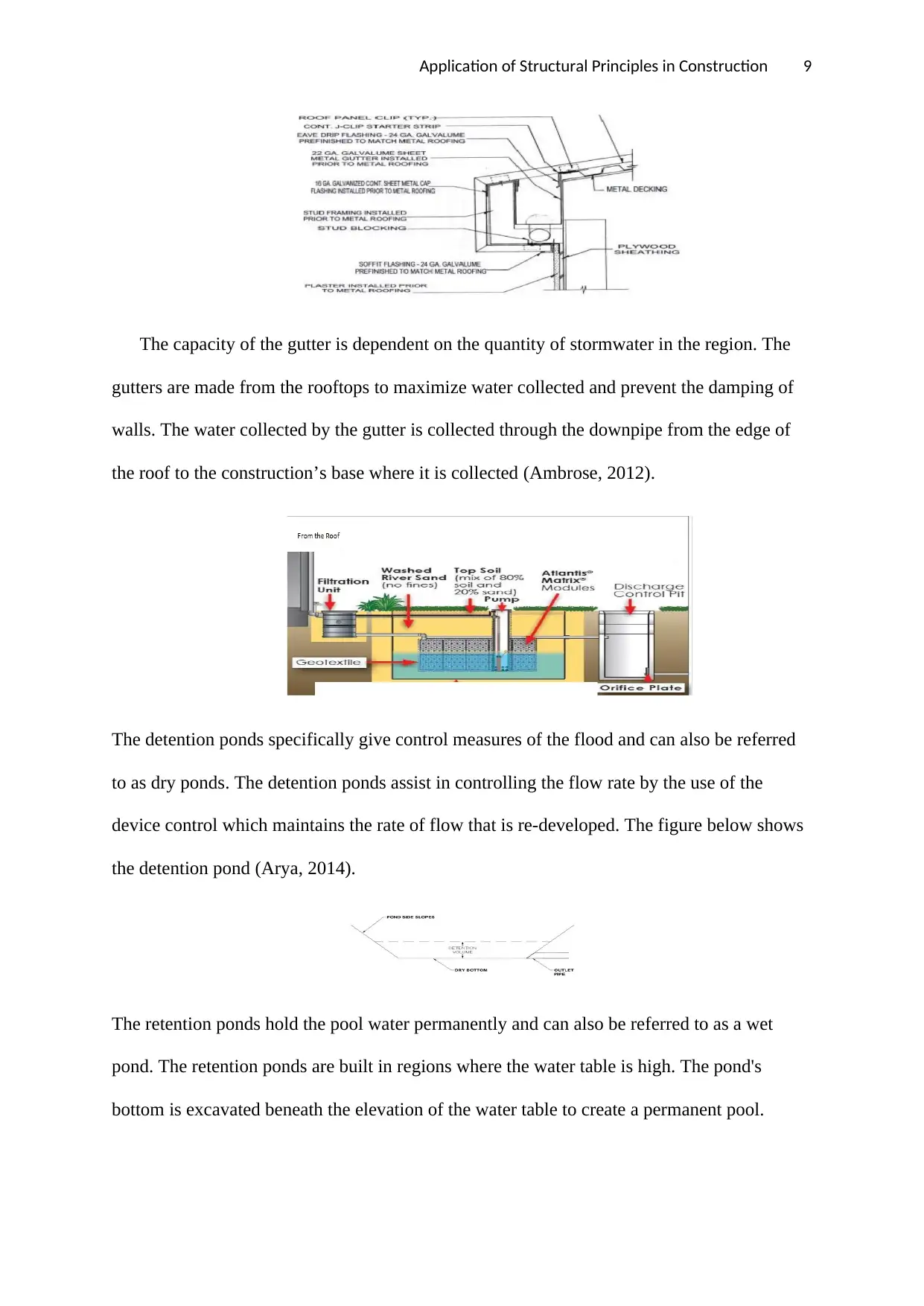
Application of Structural Principles in Construction 9
The capacity of the gutter is dependent on the quantity of stormwater in the region. The
gutters are made from the rooftops to maximize water collected and prevent the damping of
walls. The water collected by the gutter is collected through the downpipe from the edge of
the roof to the construction’s base where it is collected (Ambrose, 2012).
The detention ponds specifically give control measures of the flood and can also be referred
to as dry ponds. The detention ponds assist in controlling the flow rate by the use of the
device control which maintains the rate of flow that is re-developed. The figure below shows
the detention pond (Arya, 2014).
The retention ponds hold the pool water permanently and can also be referred to as a wet
pond. The retention ponds are built in regions where the water table is high. The pond's
bottom is excavated beneath the elevation of the water table to create a permanent pool.
The capacity of the gutter is dependent on the quantity of stormwater in the region. The
gutters are made from the rooftops to maximize water collected and prevent the damping of
walls. The water collected by the gutter is collected through the downpipe from the edge of
the roof to the construction’s base where it is collected (Ambrose, 2012).
The detention ponds specifically give control measures of the flood and can also be referred
to as dry ponds. The detention ponds assist in controlling the flow rate by the use of the
device control which maintains the rate of flow that is re-developed. The figure below shows
the detention pond (Arya, 2014).
The retention ponds hold the pool water permanently and can also be referred to as a wet
pond. The retention ponds are built in regions where the water table is high. The pond's
bottom is excavated beneath the elevation of the water table to create a permanent pool.
⊘ This is a preview!⊘
Do you want full access?
Subscribe today to unlock all pages.

Trusted by 1+ million students worldwide
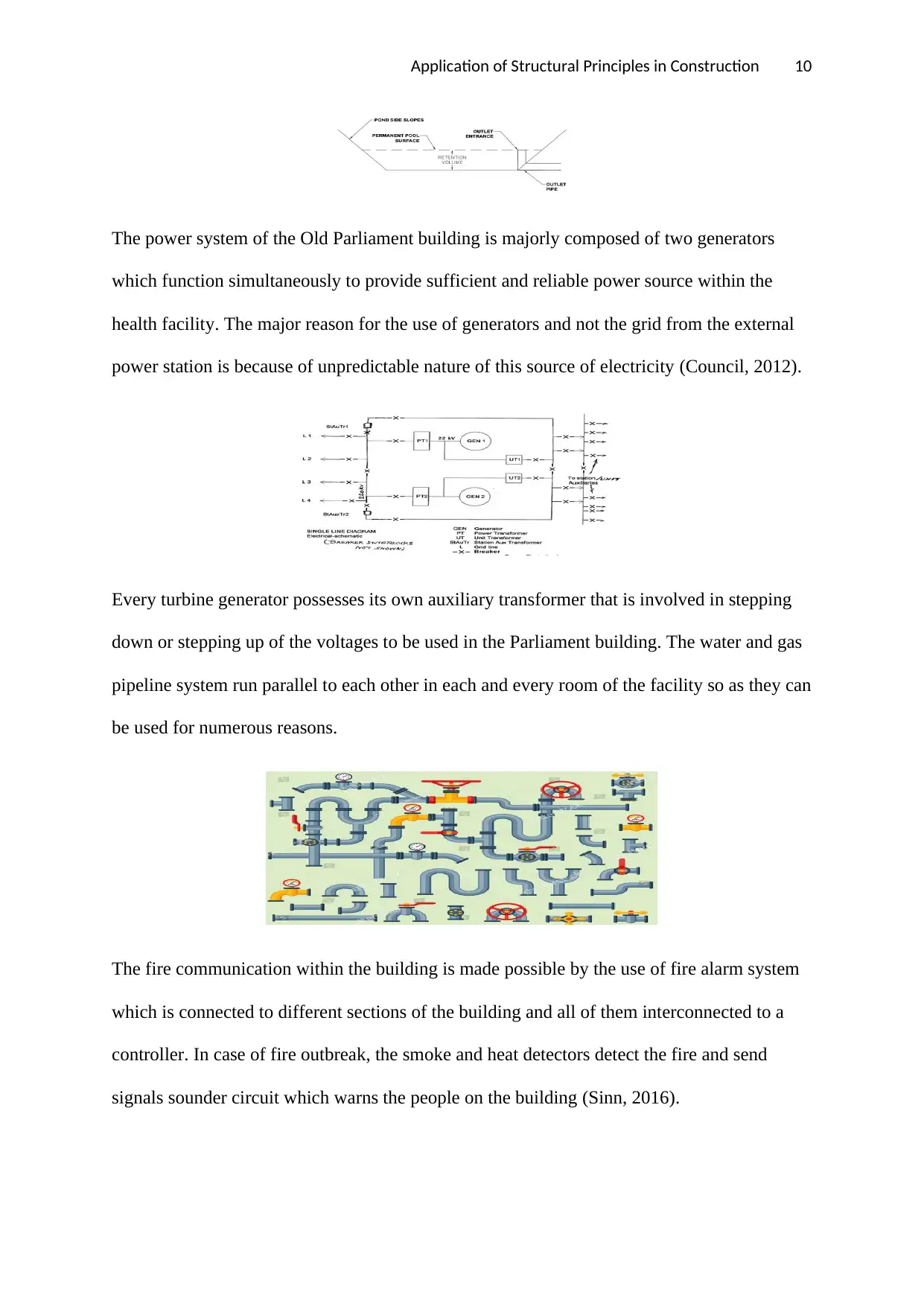
Application of Structural Principles in Construction 10
The power system of the Old Parliament building is majorly composed of two generators
which function simultaneously to provide sufficient and reliable power source within the
health facility. The major reason for the use of generators and not the grid from the external
power station is because of unpredictable nature of this source of electricity (Council, 2012).
Every turbine generator possesses its own auxiliary transformer that is involved in stepping
down or stepping up of the voltages to be used in the Parliament building. The water and gas
pipeline system run parallel to each other in each and every room of the facility so as they can
be used for numerous reasons.
The fire communication within the building is made possible by the use of fire alarm system
which is connected to different sections of the building and all of them interconnected to a
controller. In case of fire outbreak, the smoke and heat detectors detect the fire and send
signals sounder circuit which warns the people on the building (Sinn, 2016).
The power system of the Old Parliament building is majorly composed of two generators
which function simultaneously to provide sufficient and reliable power source within the
health facility. The major reason for the use of generators and not the grid from the external
power station is because of unpredictable nature of this source of electricity (Council, 2012).
Every turbine generator possesses its own auxiliary transformer that is involved in stepping
down or stepping up of the voltages to be used in the Parliament building. The water and gas
pipeline system run parallel to each other in each and every room of the facility so as they can
be used for numerous reasons.
The fire communication within the building is made possible by the use of fire alarm system
which is connected to different sections of the building and all of them interconnected to a
controller. In case of fire outbreak, the smoke and heat detectors detect the fire and send
signals sounder circuit which warns the people on the building (Sinn, 2016).
Paraphrase This Document
Need a fresh take? Get an instant paraphrase of this document with our AI Paraphraser
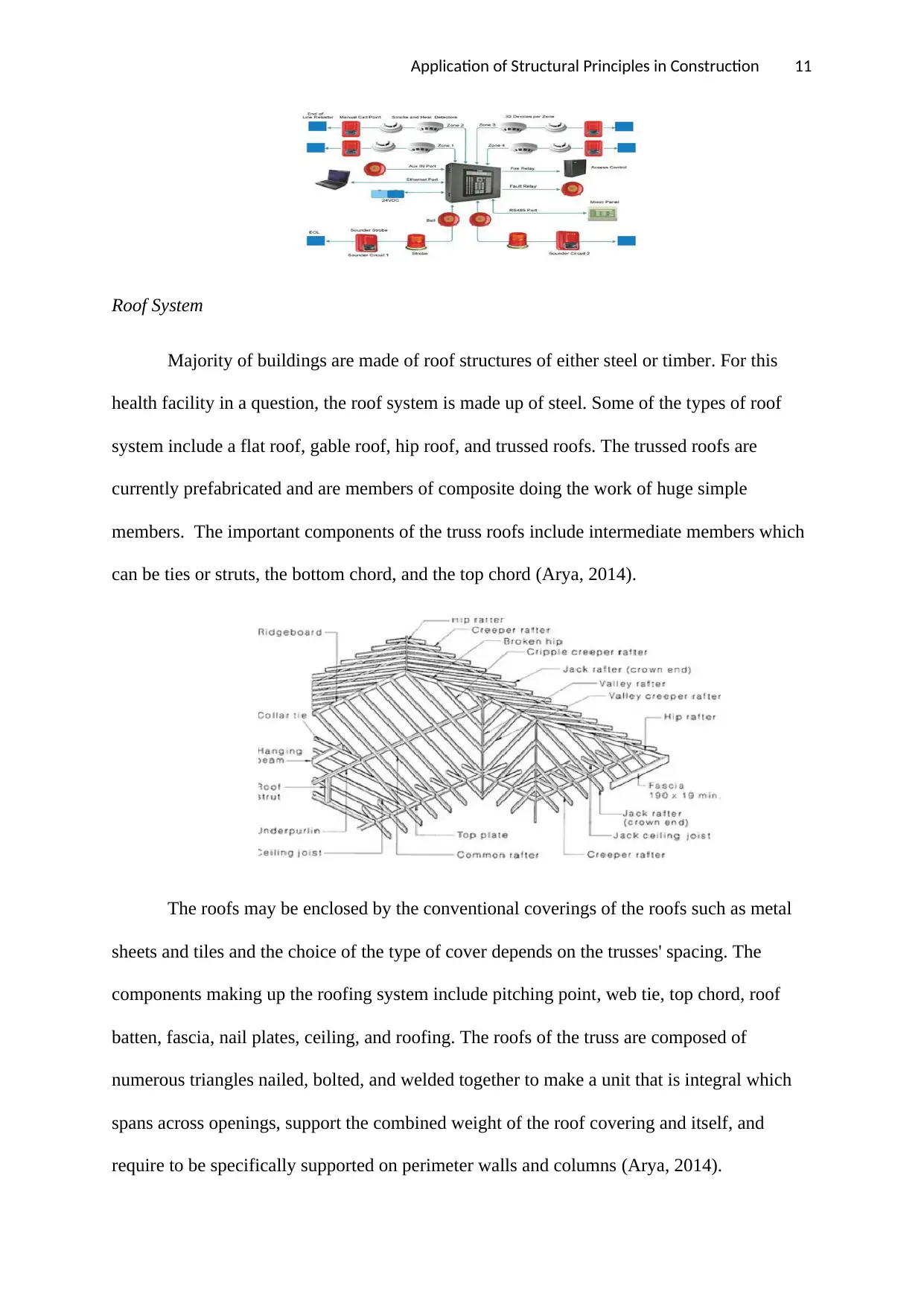
Application of Structural Principles in Construction 11
Roof System
Majority of buildings are made of roof structures of either steel or timber. For this
health facility in a question, the roof system is made up of steel. Some of the types of roof
system include a flat roof, gable roof, hip roof, and trussed roofs. The trussed roofs are
currently prefabricated and are members of composite doing the work of huge simple
members. The important components of the truss roofs include intermediate members which
can be ties or struts, the bottom chord, and the top chord (Arya, 2014).
The roofs may be enclosed by the conventional coverings of the roofs such as metal
sheets and tiles and the choice of the type of cover depends on the trusses' spacing. The
components making up the roofing system include pitching point, web tie, top chord, roof
batten, fascia, nail plates, ceiling, and roofing. The roofs of the truss are composed of
numerous triangles nailed, bolted, and welded together to make a unit that is integral which
spans across openings, support the combined weight of the roof covering and itself, and
require to be specifically supported on perimeter walls and columns (Arya, 2014).
Roof System
Majority of buildings are made of roof structures of either steel or timber. For this
health facility in a question, the roof system is made up of steel. Some of the types of roof
system include a flat roof, gable roof, hip roof, and trussed roofs. The trussed roofs are
currently prefabricated and are members of composite doing the work of huge simple
members. The important components of the truss roofs include intermediate members which
can be ties or struts, the bottom chord, and the top chord (Arya, 2014).
The roofs may be enclosed by the conventional coverings of the roofs such as metal
sheets and tiles and the choice of the type of cover depends on the trusses' spacing. The
components making up the roofing system include pitching point, web tie, top chord, roof
batten, fascia, nail plates, ceiling, and roofing. The roofs of the truss are composed of
numerous triangles nailed, bolted, and welded together to make a unit that is integral which
spans across openings, support the combined weight of the roof covering and itself, and
require to be specifically supported on perimeter walls and columns (Arya, 2014).
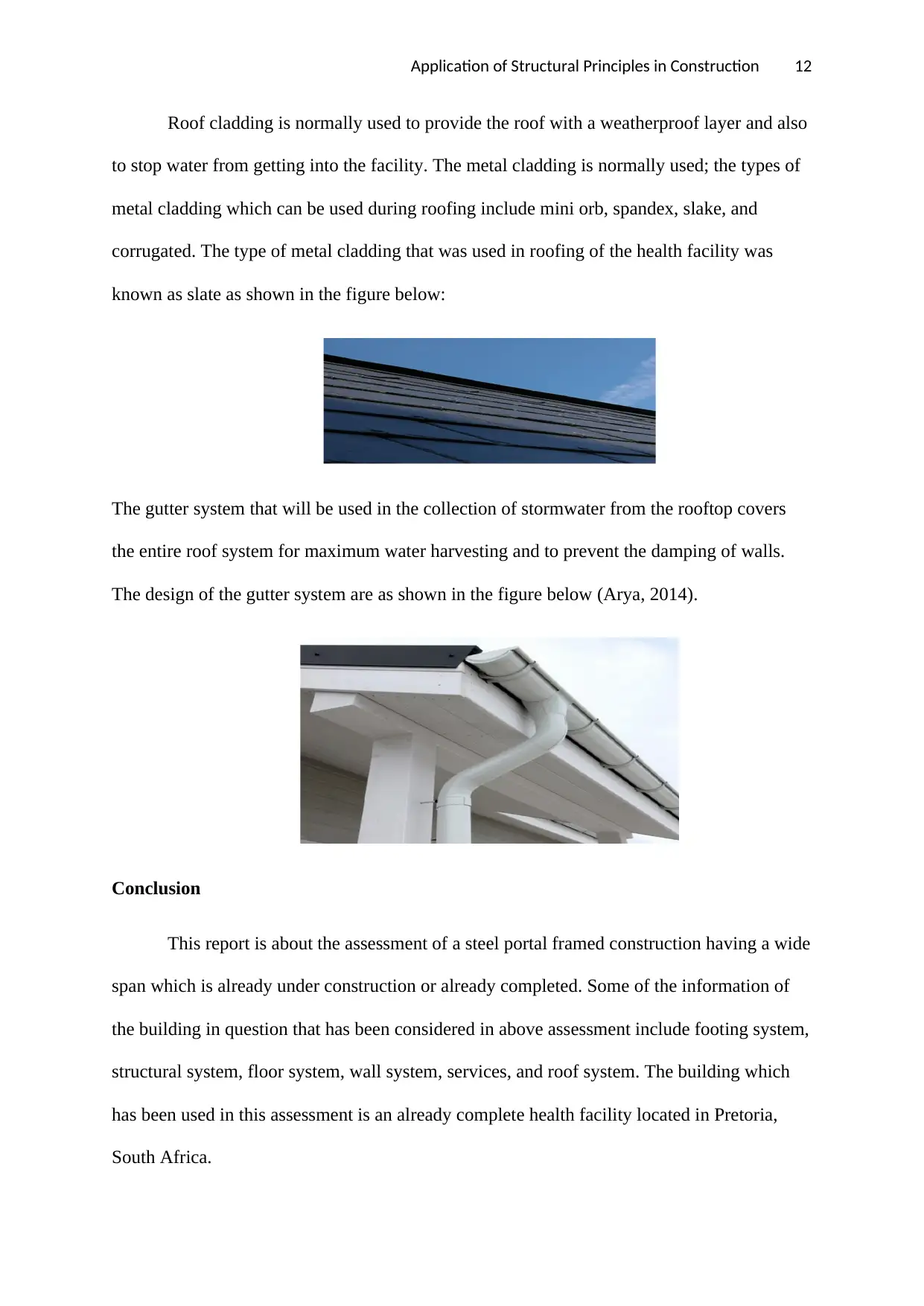
Application of Structural Principles in Construction 12
Roof cladding is normally used to provide the roof with a weatherproof layer and also
to stop water from getting into the facility. The metal cladding is normally used; the types of
metal cladding which can be used during roofing include mini orb, spandex, slake, and
corrugated. The type of metal cladding that was used in roofing of the health facility was
known as slate as shown in the figure below:
The gutter system that will be used in the collection of stormwater from the rooftop covers
the entire roof system for maximum water harvesting and to prevent the damping of walls.
The design of the gutter system are as shown in the figure below (Arya, 2014).
Conclusion
This report is about the assessment of a steel portal framed construction having a wide
span which is already under construction or already completed. Some of the information of
the building in question that has been considered in above assessment include footing system,
structural system, floor system, wall system, services, and roof system. The building which
has been used in this assessment is an already complete health facility located in Pretoria,
South Africa.
Roof cladding is normally used to provide the roof with a weatherproof layer and also
to stop water from getting into the facility. The metal cladding is normally used; the types of
metal cladding which can be used during roofing include mini orb, spandex, slake, and
corrugated. The type of metal cladding that was used in roofing of the health facility was
known as slate as shown in the figure below:
The gutter system that will be used in the collection of stormwater from the rooftop covers
the entire roof system for maximum water harvesting and to prevent the damping of walls.
The design of the gutter system are as shown in the figure below (Arya, 2014).
Conclusion
This report is about the assessment of a steel portal framed construction having a wide
span which is already under construction or already completed. Some of the information of
the building in question that has been considered in above assessment include footing system,
structural system, floor system, wall system, services, and roof system. The building which
has been used in this assessment is an already complete health facility located in Pretoria,
South Africa.
⊘ This is a preview!⊘
Do you want full access?
Subscribe today to unlock all pages.

Trusted by 1+ million students worldwide
1 out of 13
Related Documents
Your All-in-One AI-Powered Toolkit for Academic Success.
+13062052269
info@desklib.com
Available 24*7 on WhatsApp / Email
![[object Object]](/_next/static/media/star-bottom.7253800d.svg)
Unlock your academic potential
Copyright © 2020–2025 A2Z Services. All Rights Reserved. Developed and managed by ZUCOL.





